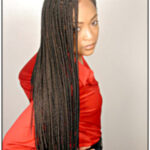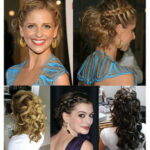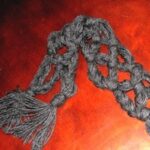Micro braiding is a fundamental art that began in Africa with many other hair braiding styles. For those with curly- and kinky-textured hair, micro braids can be an excellent alternative to chemically straightening or blow-drying hair. It is also a wonderful option for those who are interested in switching over from a chemically straightened head of hair to that of their natural texture. Micro braids allow the hair to grow out over several weeks to several months, leaving hair virtually unaffected by the elements of nature so that it may grow out very effectively.
I was taught to micro braid in 1997 while in college. At the time I attended a university in a small town with no access to African American hairstylists for at least 200 miles, so I was forced to learn to care for my own hair and fast! At the time I had never considered wearing braided extensions in my hair, but realizing my options were few, I thought I would give it a try. I quickly found that braiding my hair in this fashion was not only simple, but also long lasting, allowing my hair to grow quickly without much breakage. So now I will share with you the process of micro braiding!
Buying Extension Hair:
Of course, before inserting micro braids you must buy some hair extensions. I know many people who use synthetic hair for their braids, but I am set against this. I’ve found that synthetic hair is wiry and promotes breakage much more than human hair – so human hair is definitely my number one choice. If you are in a big city there are probably tons of beauty supply stores to buy your human hair. I suggest working with a representative in your local store to find the best color and texture match for your hair.
In choosing a length for your hair, it is better to be safe than sorry. If you have a shorter hair length (1″ – 4″) you are probably safe with any length of extension you would like. But if your hair is any longer than this, I would suggest going no shorter that 18″ in extension length so that you have room to cut the extensions or make any adjustments without compromising your own hair. Be advised that hair is usually priced by the inch, however, so know that 22″ or 24″ could be pretty expensive.
Once you’ve bought your ideal hair extensions and brought them home, you are ready for the next step – pre braid care.
Pre-Braid Care:
After my first year of braiding my hair and having it break off while still braided, I learned that pre-braid care was an essential aspect to micro braiding (or any form of braiding that requires extensions). It is very important that you condition your hair extensively and have your split ends clipped before putting in your braids. This is because if your hair was in a deteriorating state when you put in the braids, your hair will continue to deteriorate while in the braids, unbeknownst to you.
In order to avoid this, wash your hair thoroughly then use an after-shampoo conditioner (I recommend Motions After Shampoo Conditioner). I also suggest a good leave-in conditioner that requires you to wear a conditioning cap for at least 30 minutes (Organic Root Stimulator Leave-In Conditioner or Infusium Leave-In are both good).
After you’ve conditioned your hair thoroughly, oil your hair and scalp with a good conditioning oil (my favorites are Organic Root Stimulator Olive Oil and Blended Beauty Happy Nappy Styles). After oiling your hair fully, make sure to either clip all of your split ends or have someone do it for you to not promote breakage while your hair is in the braids. After you’ve done all of this, you’re ready for the next step, putting in the braids!
Inserting Micro Braids:
Over the years, I have received a lot of compliments on my micro braids followed by “Who did your hair?” When I tell them I did it, they are often in disbelief. But I always tell them they can do it too! They just need patience and time.
I am a pro at inserting very small micro braids. I make them small so that I don’t have to bother with closing the ends. Many people either don’t like very small braids or don’t have the patience to put them in; both are understandable. If you do choose larger braids I suggest also purchasing some time of bonding glue to seal your ends and prevent them from unraveling over time.
It is good to start your braiding process with a plan. First, plan on taking several days to braid your hair, with at least two days where you can afford to not be seen in public. With this being your first time, you may be really slow as you feel your way through this process, so allot yourself as much time as possible. Second, decide how you will strategically braid the hair. Normally, I make a decision to braid around the edges of my head first, then work my way to the middle, so that if I need to leave the house by day 3, I can simply pull my braids up into a ponytail at the crown of my head without anyone knowing they’re not complete.
After you’ve devised a plan, it’s time to get started. If you want neat rows, then I suggest you part your hair, one row at a time until you’ve finished. To start, take a rat-tooth comb and use the end to part your first row in a straight line. Pull the rest of your hair away from this row so that you won’t accidentally incorporate it into your braids. Then take a small section of your hair (about ¼ inch in diameter) and separate it from the row. Take the same diameter of hair extension and pull it from the grouping of hair you bought.
Find the middle of the extension (leaving an equal amount of hair hanging on either side) then bring it to the section of hair you’ve separated. Pinch that piece of separated hair and pull so that it is straight. Sit the middle of the extension on this section of hair allowing the remaining hair to fall on either side. While still holding your section of hair with one hand, hold one side of the extension against your own hair with the same hand’s thumb. Use the other hand to pull the other side of the extension and simply begin braiding all three strands together as you would any other three-strand braid. It may take a few times to feel comfortable securing the extension close to your scalp (it took me about an hour to get it right) but keep trying until you feel that the root of the extension is snug against your scalp. Be sure to braid the extensions passed your own hair’s length so that if they unravel they won’t reach your hair. Repeat this process for the remaining hair in the row then part the next row and start again. You will continue to do this until you are finished.
Side note: Be sure to have extra hair oil handy if you have a dry head to keep your unbraided hair moisturized until it is braided.
Caring for Hair in Micro Braids:
Once you have completed your entire head of hair, you will probably be relieved and want to go sit down, which I suggest! But in the coming days, you will need to oil your scalp again since it will now be exposed to the elements of nature.
Throughout the duration of wearing your braids, be it 1, 2 or even 3 months, you need to make sure to keep your hair well hydrated. Keep some braid spray handy as well as scalp oils. Only wash your hair once every 3-4 weeks because you won’t be able to properly condition your hair in the braids and this may promote breakage.
When styling your braids, I advise that you stay away from curling and flat irons for if they accidentally touch your natural hair, they could cause damage. If I ever want to wear my braids curly, I wet (not drench) my hair the night before then set it on rollers, which I take out in the morning. If I want a crimped look, I simply will wet (again, not drench) my hair then braid it in either in plats or cornrows and it is gorgeous in the morning when I take it down. Again, when you use any wet styles, make sure your hair is well hydrated so that it won’t break off without your knowing.
Removing Micro Braids:
When the time comes for you to remove your micro braids set aside about one day to do so (believe it or not, it usually takes me about 10-12 hours to remove my braids). When removing your braids, try not to tug at them from the root (as tempting as it can be) because you will split your ends in the process. Instead, unravel your braids from the bottom and work your way up as you would with any other braid, then toss the hair extensions.
Post Braid Care:
After you have pulled your braids out, you will need to comb out the excess hair that shed naturally while in the braids but had nowhere to go. This is the scary part because it will look as if all of your hair is now on the floor. Rest assured that they average head of hair loses around 50 hairs per day then calculate how long your braids have been in – you’re fine!
Usually I will check my hair over to see if there were split ends that I missed before putting the braids in and clip them. Then I will very excitedly wash and condition my hair. I don’t suggest putting chemicals in your hair immediately after pulling out braids simply because your hair needs time to adjust. If you have an in-between style that you can wear (ex. two-strand twists) try that. However, if you must put chemicals in your hair, make sure to condition your hair well then wait at least two days using chemicals.
As I said in the beginning, putting in braids can be a lengthy process requiring patience, but it is also very rewarding and provides a much-deserved hair styling break for you and your hair. I hope that I’ve been able to provide a little insight into how to micro braid and I wish you the best on your journey.
Good Luck and Happy Braiding!






